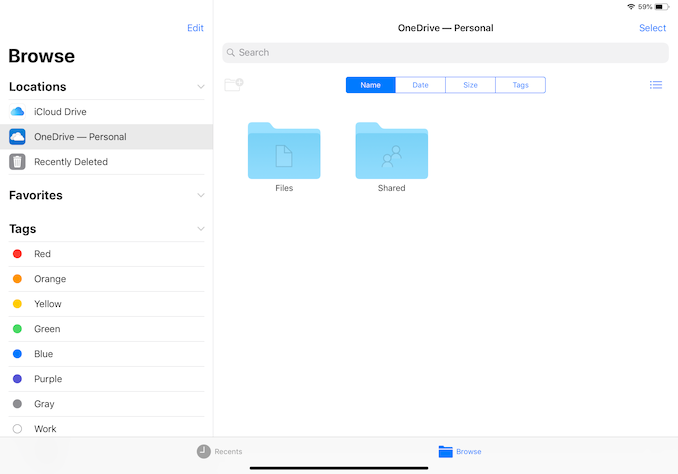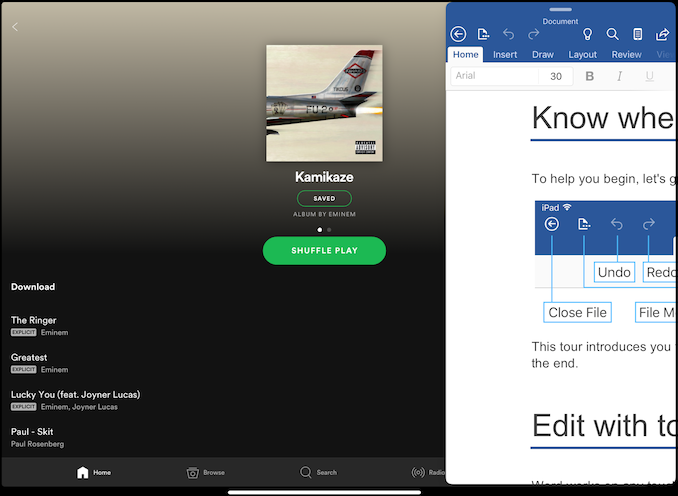The 2018 Apple iPad Pro (11-Inch) Review: Doubling Down On Performance
by Brett Howse & Andrei Frumusanu on December 4, 2018 10:00 AM ESTWireless
Apple has stuck with the same wireless solution as they offer in the iPhone, which is the Murata/Apple 339S00551 Wi-Fi controller. This is an 802.11ac 2x2:2 solution with 80 MHz channel support, and it integrated Bluetooth 5.0. The actual controller is likely a Broadcom unit, which is what Apple tends to use in its iOS devices.
Unfortunately, iOS doesn’t let us perform our standard copy script to provide peak throughput testing, so we can’t comment on that, however the iPad did lose connection the access point several times and would require a device restart to connect again. Switching to a different access point corrected this issue, but was a less than ideal solution.
On the cellular side, Apple has outfitted the LTE versions with Intel’s XMM 7560 modem, which offers Category 16 downloads.
Audio
As mentioned in the design section, the iPad Pro features four sets of speakers, with both a tweeter and woofer for each corner. There are drilled holes in the aluminum chassis to let the sound out, and the iPad offers dynamic audio based on its rotation so that the left and right channels of audio are directed to the correct side. If you turn the iPad 180°, the left and right channels will switch to keep the stereo correct. It is a great system that works flawlessly.
The actual speakers on the iPad sound very good, and on playback of a test track, were able to achieve around 85 dB(A) measured one inch over the device. There is no distortion, and the speaker range was quite good for a small device.
The bad news is if you want to connect your favorite headphones to the iPad, there is no longer a 3.5 mm jack. The reasoning behind the removal on the iPhone was due to space concerns, but on a larger device like the iPad, that seems like a weak argument. In addition, there’s no 3.5 mm USB-C adapter in the box either, so if you do want to use wired headphones, you’ll need to purchase an adapter. This is obviously less than ideal.
Cameras
Apple offers a 7 MP front facing camera with f/2.2, Smart HDR, wide color support, and "Retina Flash", which means it will use the display as a flash for the front facing camera. The front facing camera works well for Face Time, which is what it is really designed for, although the location of the camera in the top bezel in portrait means that it won’t work well in landscape, since everything is off-center. Ideally, Apple could offer two sets of cameras, which would also help out with Face ID.
The rear camera is a 12 MP f/1,8 with PDAF, Smart HDR, wide color support, and True Tone Quad-LED flash.
The rear camera is quite good, likely on-par with the iPhone XR.
![]()
Google Pixel XL camera samples
Due to the weather (it’s winter in Canada) the only samples here are from indoor shots compared against the Google Pixel XL.
Software
As I mentioned towards the start of this review, as Apple is pitching the iPad Pro as a professional productivity machine, I opted to go into this review focusing on just that. Meaning the competition for the iPad Pro isn't so much other ARM-based tablets, but rather similarly-capable business machines like the Surface Pro series or Lenovo's various Yoga devices. At this point I don't think the iPad Pro's pedigree in terms of hardware is in question. But rather it's a question of whether the software can do everything that a professional machine should be able to. The iPad is inseparable from iOS, for all the benefits and drawbacks that can bring.
Apple wants the iPad Pro to be a professional, or at least prosumer, level of device. And in order to achieve that they need not only the operating system, but also the applications available for people to get work done. The iPad’s success over the years was always offering easy access to content, but only in the last couple of generations has Apple put serious effort into letting people get work done on it via the iPad Pro family.
 The Files app doesn't provide access to any files on the device
The Files app doesn't provide access to any files on the device
iOS has come a long way in terns of its ability to multitask, but with the gesture based navigation it can be a bit cumbersome to switch applications on the fly. Over time, you do get better at it, but it still doesn’t compare to the PC. The four-finger swipe to switch between open applications is quick, but if you have several open it can be slow to get where you need to go. iOS 12 of course still supports the Split View and Slide Over modes as well. There’s also no file system access, other than the rudimentary Files application, and Apple has decided not to allow regular USB drives to be connected and used to transfer media. You can hook up a camera card and import the photos, and there are various iOS-specific drives out there that work on an application-by-application basis, but the only way to move the files off of the iPad is generally through the cloud.
 Since iOS requires the app developers to explicitly support their multitasking modes, if you want Word open with Spotify at the same time, this is your only option
Since iOS requires the app developers to explicitly support their multitasking modes, if you want Word open with Spotify at the same time, this is your only option
What it boils down to is that the iPad Pro offers a tremendous amount of performance, but at this point it feels held back by iOS. If you have a workflow that you know works well in iOS, it will almost certainly work better on the iPad Pro. But if you have a workflow from the PC, that will need to be adjusted to make it fit the iPad.
That’s not necessarily a bad thing. There are clearly people who can not only make the iPad work, but find it to be a better tool than what they had in the past, but that is not always the case. With more professional applications coming to iOS, this could improve over time as well, and Adobe in particular has been a strong supporter of iOS with their Creative Cloud applications.
Other features are also left wanting, such as the ability to hook the iPad Pro up to a 5K display over USB-C. At the OS level the only option here is to mirror the iPad display, but since the display you are connecting to likely doesn’t offer touch, and there’s no pointer support in iOS, it literally is just a cropped version of the iPad display on another screen. Apps can take advantage of the second display, such as a presentation which would offer a different experience on both displays, but it doesn’t offer the flexibility of the PC or Mac with regards to connecting extra monitors.
There are hundreds of small issues like this that you’ll run into when using iOS for professional-level productivity. Some of them will be real issues, and some of them will just be re-learning tasks. There’s no doubt you can get work done on the iPad Pro, but the question is if you can do it as efficiently as you are used to. If you can, great. This iPad is for you.













145 Comments
View All Comments
Spunjji - Wednesday, December 5, 2018 - link
Honestly wondered this too. Apple don't seem to like performance segmentation at the top-end, and I'd bet that 1TB unit uses TLC flash, so extra caching in system RAM would massively help performance and longevity. Just a supposition though.Socius - Wednesday, December 5, 2018 - link
I picked up the 1TB model for the 6GB of ram. Apps/games stay in memory far longer than they do on the iPhone XS Max with 4GB of ram. Of course, that could also be related to the way iOS is designed to perform on iphones vs. ipads. But either way, the 1TB model also has a much faster disk. If you use your iPad for productivity, I would try to find a way to justify the extra expenditure. My justification was the pending release of Adobe Photoshop, as well as trying to do some of my 4K video editing strictly on the iPad.Speedfriend - Tuesday, December 4, 2018 - link
If the single core power consumption is 3.6-4.3, what would it be at most stressed multicore?eastcoast_pete - Tuesday, December 4, 2018 - link
Writing this as somebody who is not an iOS fan or Apple fanboy, this tablet is clearly the reigning king of tablets, with the pricing to match. However, a laptop replacement it is not, despite what Apple keeps saying. The one aspect that I did find disappointing is the rear camera setup; despite statement by some of Apple's head-honchos, plenty of people I know do use their tablet (usually iPads) for photography, and for the current iPad Pro prices, Apple could have thrown in the camera setup from the iPhone XS.KPOM - Tuesday, December 4, 2018 - link
I think what Apple is saying is that it does what most people need a computer to do, not that it would replace everything a notebook does. For me, it does about 90% of what I need. This plus a low-end ultralight notebook with a big screen would be all I need right now. My employer insists on giving me a quad-core notebook that weighs a bulky 3.5 lbs. I’d take a Spectre over my PC setup. On business trips, the iPad is all I need.WasHopingForAnHonestReview - Wednesday, December 5, 2018 - link
So, email. K.crash86 - Tuesday, December 4, 2018 - link
On the GPU test - it looks like there is no change in resolution between the iPAD 1112x834 and 2224x1668 settings. Instead, it looks like the rendered resolution is exactly the same, just scaled by 2X (the @2.0?). Are you sure the rendered resolution actually changed between the tests? It seems unreasonable that the average / frame would be completely unchanged.Ryan Smith - Tuesday, December 4, 2018 - link
We're sure.Take a good look at the photos. The Retina resolution photos are far clearer since they're not being internally rendered at 1/4 resolution.
tipoo - Tuesday, December 4, 2018 - link
That's wild.*ask to render 4x more pixels*
A12X: *Shrugs*
KateH - Wednesday, December 5, 2018 - link
the author said the framerate appeared to be capped at 27fps (presumably for the sake of power consumption and thermals). So we don't know how fast it could render Civ at full tilt, only that it's at least 27fps at both resolutions. I assume this just means the GPU is just working less hard to hit the framerate at the lower resolution, but we don't know how much... Apple may have GPU design chops but even they can't magic their way out of resolution performance scaling limits, only obfuscate said limits ;)